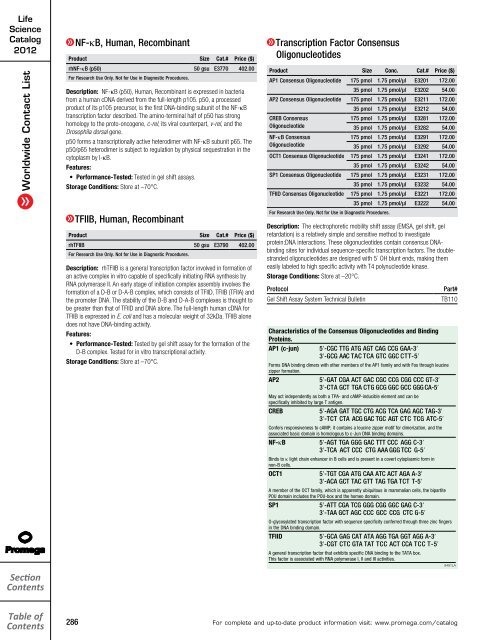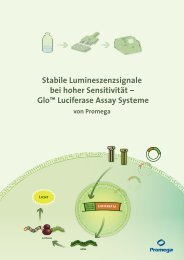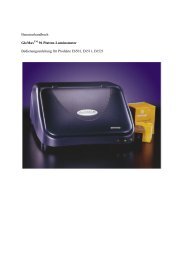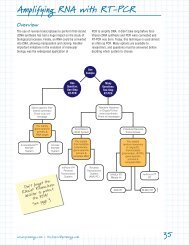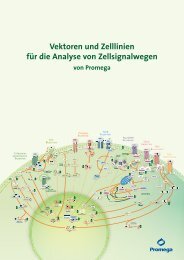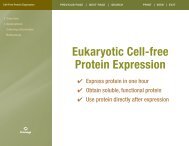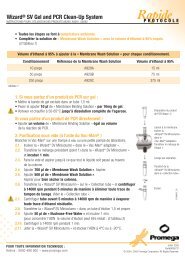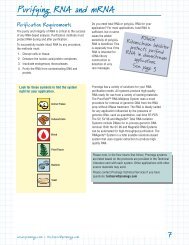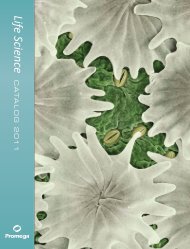Life Science - Promega
Life Science - Promega
Life Science - Promega
Create successful ePaper yourself
Turn your PDF publications into a flip-book with our unique Google optimized e-Paper software.
<strong>Life</strong><br />
<strong>Science</strong><br />
Catalog<br />
2012<br />
Worldwide Contact List<br />
Section<br />
Contents<br />
Cell Signaling<br />
NF-κB, Human, Recombinant<br />
Product Size Cat.# Price ($)<br />
rhNF-κB (p50) 50 gsu E3770 402.00<br />
For Research Use Only. Not for Use in Diagnostic Procedures.<br />
Description: NF-κB (p50), Human, Recombinant is expressed in bacteria<br />
from a human cDNA derived from the full-length p105. p50, a processed<br />
product of its p105 precursor, is the first DNA-binding subunit of the NF-κB<br />
transcription factor described. The amino-terminal half of p50 has strong<br />
homology to the proto-oncogene, c-rel, its viral counterpart, v-rel, and the<br />
Drosophila dorsal gene.<br />
p50 forms a transcriptionally active heterodimer with NF-κB subunit p65. The<br />
p50/p65 heterodimer is subject to regulation by physical sequestration in the<br />
cytoplasm by I-κB.<br />
Features:<br />
• Performance-Tested: Tested in gel shift assays.<br />
Storage Conditions: Store at –70°C.<br />
TFIIB, Human, Recombinant<br />
Product Size Cat.# Price ($)<br />
rhTFIIB 50 gsu E3790 402.00<br />
For Research Use Only. Not for Use in Diagnostic Procedures.<br />
Description: rhTFIIB is a general transcription factor involved in formation of<br />
an active complex in vitro capable of specifically initiating RNA synthesis by<br />
RNA polymerase II. An early stage of initiation complex assembly involves the<br />
formation of a D-B or D-A-B complex, which consists of TFIID, TFIIB (TFIIA) and<br />
the promoter DNA. The stability of the D-B and D-A-B complexes is thought to<br />
be greater than that of TFIID and DNA alone. The full-length human cDNA for<br />
TFIIB is expressed in E. coli and has a molecular weight of 32kDa. TFIIB alone<br />
does not have DNA-binding activity.<br />
Features:<br />
• Performance-Tested: Tested by gel shift assay for the formation of the<br />
D-B complex. Tested for in vitro transcriptional activity.<br />
Storage Conditions: Store at –70°C.<br />
Transcription Factor Consensus<br />
Oligonucleotides<br />
Product Size Conc. Cat.# Price ($)<br />
AP1 Consensus Oligonucleotide 175 pmol 1.75 pmol/µl E3201 172.00<br />
35 pmol 1.75 pmol/µl E3202 54.00<br />
AP2 Consensus Oligonucleotide 175 pmol 1.75 pmol/µl E3211 172.00<br />
35 pmol 1.75 pmol/µl E3212 54.00<br />
CREB Consensus<br />
175 pmol 1.75 pmol/µl E3281 172.00<br />
Oligonucleotide<br />
35 pmol 1.75 pmol/µl E3282 54.00<br />
NF-κB Consensus<br />
175 pmol 1.75 pmol/µl E3291 172.00<br />
Oligonucleotide<br />
35 pmol 1.75 pmol/µl E3292 54.00<br />
OCT1 Consensus Oligonucleotide 175 pmol 1.75 pmol/µl E3241 172.00<br />
35 pmol 1.75 pmol/µl E3242 54.00<br />
SP1 Consensus Oligonucleotide 175 pmol 1.75 pmol/µl E3231 172.00<br />
35 pmol 1.75 pmol/µl E3232 54.00<br />
TFIID Consensus Oligonucleotide 175 pmol 1.75 pmol/µl E3221 172.00<br />
35 pmol 1.75 pmol/µl E3222 54.00<br />
For Research Use Only. Not for Use in Diagnostic Procedures.<br />
Description: The electrophoretic mobility shift assay (EMSA, gel shift, gel<br />
retardation) is a relatively simple and sensitive method to investigate<br />
protein:DNA interactions. These oligonucleotides contain consensus DNAbinding<br />
sites for individual sequence-specific transcription factors. The doublestranded<br />
oligonucleotides are designed with 5´ OH blunt ends, making them<br />
easily labeled to high specific activity with T4 polynucleotide kinase.<br />
Storage Conditions: Store at –20°C.<br />
Protocol<br />
Gel Shift Assay System Technical Bulletin<br />
Part#<br />
TB110<br />
Characteristics of the Consensus Oligonucleotides and Binding<br />
Proteins.<br />
AP1 (c-jun) 5ʹ-CGC TTG ATG AGT CAG CCG GAA-3ʹ<br />
3ʹ-GCG AAC TAC TCA GTC GGC CTT-5ʹ<br />
Forms DNA binding dimers with other members of the AP1 family and with Fos through leucine<br />
zipper formation.<br />
AP2<br />
5ʹ-GAT CGA ACT GAC CGC CCG CGG CCC GT-3ʹ<br />
3ʹ-CTA GCT TGA CTG GCG GGC GCC GGG CA-5ʹ<br />
May act independently as both a TPA- and cAMP-inducible element and can be<br />
specifi cally inhibited by large T antigen.<br />
CREB<br />
5ʹ-AGA GAT TGC CTG ACG TCA GAG AGC TAG-3ʹ<br />
3ʹ-TCT CTA ACG GAC TGC AGT CTC TCG ATC-5ʹ<br />
Confers responsiveness to cAMP; it contains a leucine zipper motif for dimerization, and the<br />
associated basic domain is homologous to c-Jun DNA binding domains.<br />
NF-κB<br />
5ʹ-AGT TGA GGG GAC TTT CCC AGG C-3ʹ<br />
3ʹ-TCA ACT CCC CTG AAA GGG TCC G-5ʹ<br />
Binds to κ light chain enhancer in B cells and is present in a covert cytoplasmic form in<br />
non-B cells.<br />
OCT1<br />
5ʹ-TGT CGA ATG CAA ATC ACT AGA A-3ʹ<br />
3ʹ-ACA GCT TAC GTT TAG TGA TCT T-5ʹ<br />
A member of the OCT family, which is apparently ubiquitous in mammalian cells, the bipartite<br />
POU domain includes the POU-box and the homeo domain.<br />
SP1<br />
5ʹ-ATT CGA TCG GGG CGG GGC GAG C-3ʹ<br />
3ʹ-TAA GCT AGC CCC GCC CCG CTC G-5ʹ<br />
O-glycosylated transcription factor with sequence specifi city conferred through three zinc fi ngers<br />
in the DNA binding domain.<br />
TFIID<br />
5ʹ-GCA GAG CAT ATA AGG TGA GGT AGG A-3ʹ<br />
3ʹ-CGT CTC GTA TAT TCC ACT CCA TCC T-5ʹ<br />
A general transcription factor that exhibits specifi c DNA binding to the TATA box.<br />
This factor is associated with RNA polymerase I, II and III activities.<br />
9491LA<br />
Table of<br />
Contents<br />
286<br />
For complete and up-to-date product information visit: www.promega.com/catalog


